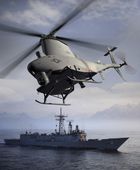Northrop Grumman
Latest Stories

MQ-8B
NUMBER 3. MQ-8 FIRE SCOUT is an unmanned autonomous helicopter developed by Northrop Grumman for use by the United States Armed Forces. The Fire Scout is designed to provide reconnaissance, situational awareness, aerial fire support and precision targeting support for ground, air and sea forces. The initial RQ-8A version was based on the Schweizer 330, while the enhanced MQ-8B was derived from the Schweizer 333. The larger MQ-8C variant is based on the Bell 407. (Photo Illustration)

X-47B
The Northrop Grumman X-47B is a demonstration unmanned combat air vehicle (UCAV) designed for carrier-based operations. Developed by the American defense technology company Northrop Grumman, the X-47 project began as part of DARPA's J-UCAS program, and is now part of the United States Navy's Unmanned Combat Air System Demonstration (UCAS-D) program. The X-47B first flew in 2011, and as of 2013, it is undergoing flight testing, having successfully performed a series of land- and carrier-based demonstrations. Northrop Grumman intends to develop the prototype X-47B into a battlefield-ready aircraft, the Unmanned Carrier-Launched Surveillance and Strike (UCLASS) system, which will enter service by 2019. ATLANTIC OCEAN (May 14, 2013) An X-47B Unmanned Combat Air System (UCAS) demonstrator flies near the aircraft carrier USS George H.W. Bush (CVN 77). George H.W. Bush is the first aircraft carrier to successfully catapult launch an unmanned aircraft from its flight deck. (U.S. Navy photo by Erik Hildebrandt/Released)

MQ-8C_Fire_Scout
The Northrop Grumman MQ-8 Fire Scout is an unmanned autonomous helicopter developed by Northrop Grumman for use by the United States Armed Forces. The Fire Scout is designed to provide reconnaissance, situational awareness, aerial fire support and precision targeting support for ground, air and sea forces. The initial RQ-8A version was based on the Schweizer 330, while the enhanced MQ-8B was derived from the Schweizer 333. The larger MQ-8C variant is based on the Bell 407. In this Sept. 5, 2013 photo provided by Northrop Grumman, a MQ-8C Fire Scout unmanned helicopter sits on the flight line at Naval Base Ventura County Point Mugu, Calif., prior to conducting the first engine runs of the system on Sept. 20, 2013. A Northrop Grumman and U.S. Navy test team is collecting data to ensure that all of the aircraft's systems are functioning and communicating properly prior to its first flight. (AP Photo/Chad Slattery, Northrop Grumman)

MQ-4C_Triton
The Northrop Grumman MQ-4C Triton is an unmanned aerial vehicle (UAV) under development for the United States Navy as a surveillance aircraft. In tandem with its associated ground control station, it is considered an unmanned aircraft system (UAS). Developed under the Broad Area Maritime Surveillance (BAMS) program, the system is intended to provide real-time intelligence, reconnaissance missions (ISR) over vast ocean and coastal regions,continuous maritime surveillance, as well as search and rescue missions, for the U.S. Navy, and to complement the Boeing P-8 Poseidon maritime patrol aircraft. Triton builds on elements of the Global Hawk UAS while incorporating reinforcements to the air frame and wing, along with de-icing and lightning protection systems. These capabilities allow the aircraft to descend through cloud layers to gain a closer view of ships and other targets at sea when needed. The current sensor suits allow ships to be tracked over time by gathering information on their speed, location, and classification. The MQ-4C System Development and Demonstration (SDD) aircraft was delivered in 2012 and the MQ-4C UAS was originally expected to be operational by late 2015 with a total of 68 aircraft to be procured. However, in April 2013, the Navy announced that production has shifted from FY14 to FY15 due to additional testing requirements and technical issues related to the aircraft's double-tail vertical stabilizer and rudder, and software integration for maritime sensors.[7] According to the latest information available from the Naval Air Systems Command (NAVAIR), the Initial Operational Capability (IOC) for the MQ-4C UAS is now planned for 2017. PALMDALE, Calif. (May 21, 2013) Two Northrop Grumman MQ-4C Triton unmanned aerial vehicles are seen on the tarmac at a Northrop Grumman test facility in Palmdale, Calif. Triton is undergoing flight testing as an unmanned maritime surveillance vehicle. (U.S. Navy photo courtesy of Northrop Grumman by Chad Slattery/R

Drones 101.JPEG-09b88.jpg
This undated photo released Thursday, May 30, 2013 by aerospace technology company Northrop Grumman shows the RQ-4 Block 20 Global Hawk unmanned aircraft that students in the University of North Dakota aviation program will learn to fly. (AP Photo/Courtesy of Northrup Grumman)


